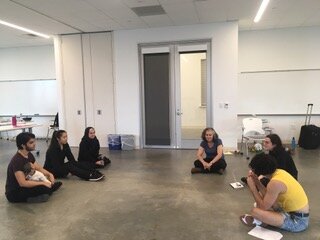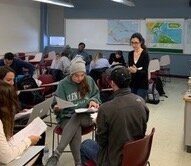ACTS OF DISPLACEMENT
Under the direction of Esther Fernández, the goal of this course/workshop at Rice University was to give students the opportunity to approach Spanish dramatic literature through a creative and experiential learning process. We focused on a selection of contemporary Spanish plays that address the notion of exodus through which we considered the current refugee crisis in dialogue with political corruption, deportation, and harassment and violence against refugee women. While half of the course was devoted to studying the plays from a literary, critical and analytical lens, the other half was dedicated to exploring theatre through various aspects of staging, such as dramaturgy, acting, translation, setting, costume and sound design. Students worked in groups to create a series of original plays and pedagogical material to perform outreach around, the topic of the refugees, migration and exile. Puppets were the main artistic form to communicate these stories.
Why Puppets and Displacement?
“No Soy”
Artists’ Statement
“No soy” [I’m Not] is based on a poem by Arabic writer Jalal Al-Din Al-Rumi. Our rendition integrates three languages: English, Spanish, and Arabic, to convey the idea that a human being is not limited by social constructs and that the sharing of cultures can overcome all differences. The poem begins with each distinct language presenting a similar idea, but in their own individual ways. As it unfolds, the languages interact more and more with each other up until the moment they converge to form an uninterrupted harmony of thought.
“El muro”
Artists’ Statement
El muro [The Wall] was inspired by Refugio [Refuge] (2017) by Miguel del Arco, a play about a Middle Eastern migrant, Farid, who, after losing his wife and son while crossing the sea, is taken into the home of a corrupt Spanish politician and his family. One of the major themes within Refugio is the profound isolation that Farid experiences – he feels alone in the midst of ruin and familial dysfunction, held back by linguistic and cultural barriers. In El muro, we adapt Farid’s story to the situation faced by Latin American migrants who move to the United States.
In this contemporary political climate, the intimate experiences of those who cross the border between the United States and Mexico are often overshadowed, if not entirely forgotten. El muro explores the interpersonal effects of this crossing, particularly among the migrants themselves. We focus on representing varying types of distance – distance that exists across each side of the border, between freedom and oppression, between life and death. Many Americans still have harsh preconceptions about migrants, particularly those who are undocumented.
The dialogue within El muro inverts the relation between migrant and native – a conversation that establishes a space to reflect on social and political progress, but also creates an idea of ‘otherness’. The migrant exists solely as a foil to the native, dehumanizing them. El muro, however, humanizes the migrant and engenders a profound empathy toward their experiences.
“La llave”
Artists’ Statement
La llave [The Key] is an adaptation of the play La frontera (2003) by Laila Ripoll and the short stories by Juan Rulfo from El llano en llamas (1953). It tells the story of a young man and his grandmother, an Spanish exile who left during the Spanish Civil War, in their journey through the desert to the U.S.-Mexican border. The action of the play centers itself on the dispute between the two of them, focusing on themes of cultural abandonment and the condition of the migrant outside of his or her native land.
The history problematizes the meaning of “belonging to no place” for the migrant. Through an intergenerational conversation, we attempt to contextualize the difficulty of abandoning one’s homeland turning to a place where someone “has no roots.” The narrative demystifies the United States as a “land of opportunities,” an image that is fading day by day.
The puppet that represents the grandmother is perched on the shoulders of the actor throughout the play. It symbolizes the weight on the conscience of younger generations. The puppet allows a physical representation of the grandmother’s ghost that returns to life in the mind of the young man. Her presence shows the duty of the young man to not abandon his customs or his family history while he treks on.
“Todo para ti”
Artists’ Statement
Todo para ti [Everything for you] is based on two shorts from Invisibles: Voces de un trozo invisible de este mundo by Juan Diego Botto (2013): (1) “La carta” narrates how two African children froze to death in the landing gear of a plane on their to Europe; (2) “Mujer” describes the life of a single mother who recounts her experience as a refugee in Spain to her son. In our rendition, the protagonist, Fodé Koita, is a Guinean child, hidden in the landing gear of a plan, in search of his mother. Fodé appears split into two beings: his physical body and his mind. The mother appears as an isolated character while she tells her story to her son, who she imagines by her side and who we bring to life with a puppet.
The mother had to leave him behind when she took refuge in Europe. But what did she end up finding in that dreamed continent? At first, nothing more than abuse and dehumanization, but, little by little, she discovered her purpose. The only thing that was missing was her dear son, Fodé.
Our puppet symbolizes all those refugees who were silenced or lost their lives in their search for something better. Todo para ti is a tribute to the richness found in the life of a refugee, to their dreams, their hopes, and their blissful moments.
This work is dedicated to all those who have had to fight for a better life.
“Europa”
Artists’ Statement
“Europa” is based on several scenes from the play Refugio, written by Miguel Del Arco, in which the most prominent themes are corruption and the dire situation of refugees who embark in a new life in Europe. The title is based on the Greek myth of Europa, which the central character, Farid, references in the story to exalt the image of a mythological land that stands in stark contrast to present day Europe. As Farid seeks refuge from his own corruption and the problem that plagues his waking thoughts: the death of his wife and child, who drowned in the ocean in the past as they tried to reach the promised land. Farid is tormented by memories of the past and the present, as he is in search for the sanctuary that he so desperately seeks -- eternal silence of his dead wife. When Sima, his wife, haunts the thoughts of Farid, he is blaming himself for their drowning. Sima haunts his thoughts to remind him that he chose to save his own life instead of saving the lives of his loved ones. In that way, Farid is blaming himself for their deaths, because the character that haunts his thoughts is simply a figment of his imagination. He tells himself: “I returned to life to hopelessly long for death.” With this line, the man accepts that he will not find refuge in his corrupt life, but in death.
“Distinto”
An ensemble performance based on the poem by Juan Ramón Jiménez.







































